HP ProLiant DL360 Gen9 Server - Review, Test, and Prospects
Review HP ProLiant DL360 Gen9
With the advent of Intel's Xeon E5-2600 v3 family of processors, many vendors have begun releasing computing platforms that take advantage of the increased performance of the new Xeon architecture. The DL360 Gen9 is the new 1U serial computing platform in the HP ProLiant family, and in addition to the new E5-2600 v3 processors and DDR4 memory, the DL360 Gen9 reflects HP's technological advances and the company's overall vision for converged data centers.

Like the larger DL380 Gen9 platform with a 2U form factor, the DL360 enhances the performance of Intel Xeon E5-2600 v3 processors. In combination with HP SmartMemory DDR4 memory modules, server capacity can be increased up to 768 GB, speed up to 2 133 MHz, in contrast to the maximum speed of 1 866 MHz on previous generation Gen 8 processors with DDR3 memory. The new E5-2600 v3 processors have up to 18 cores and can increase productivity per watt by three times compared to the Gen8 ProLiant servers. For DL360 servers, the latest generation of Smart Array Controller controllers with a speed of 12 Gb / s and PCIe accelerators are suitable. Unlike its predecessors, the DL360 Gen9 supports GPUs: up to two active cards with a single width of up to 9.5 inches in length.
The device tested in this review uses a DL360 chassis with a 1U form factor with 8 bays for a small form factor drive, equipped with two Intel Xeon E5-2697 v3 2.6GHz processors, 256 GB of RAM (16 DIMM slots of 16 GB 2Rx4 PC4 -2133) and five 400 GB SAS Small Form Factor SSDs. The device under test does not have a universal Media Bay, but it can optionally be used to accommodate two additional bays for a small form factor drive or an optical drive and a VGA connector with front access. We use a PCA FLR 10GbE SFP dual-connector transceiver + interface board for network connection.

HP ProLiant DL360 Gen9 Specifications:
- Processors: Intel Xeon E5-2600 v3 Product Family
- Number of processors: 2
- Number of processor cores: 4, 6, 8, 10, 12, 14, 16 or 18
- Form Factor: 1U
- Power Supply: (2) Flex Slot
- Expansion slots: (3) maximum.
- Maximum memory capacity: 768 GB DDR4 HP SmartMemory
- Memory slots: 24 DIMM slots up to 2 133MHz
- Storage devices: (8) SAS / SATA drives of small form factor + universal bay Media Bay or (4) drives of SAS / SATA drives of large form factor
- Network: 4 x 1GbE + FlexibleLOM slot
- Network controller: Broadcom 5720 and / or FlexFabric 10Gb 533FLR-T adapter.
- Dynamic Smart Array B140i controller
- H240ar main bus adapter
- Smart Array P440ar / 2GB FBWC controller
- Flash-backed write cache (FBWC): 2GB DDR3-1.866MHz, 72-bit wide bus 14.9Gb / s on P440ar
- Battery: HP DL / ML / SL 96W Smart Storage Battery
- Rear VGA Port, Serial I / O Port, 5x USB 3.0 Ports
- Support for GPUs: two active single-width cards up to 9.5 inches in length up to 150W each.
- Local Management: HP OneView and HP iLO Advanced
- Cloud Management: HP Insight Online with the mobile app
- Power and cooling: up to 94% efficiency (Platinum Plus) with HP Flexible Slot FF
- N + 1 hot-swappable fans, optional high-performance fans
- Compliance with production requirements: ASHRAE A3 and A4, energy-saving standby
- Form Factor / Chassis Depth: Upright (1U), 27.5 '' (Small Form Factor), 29.5 '' (Large Form Factor)
- Microsoft Windows Server: 2008 R2 (x64 only), 2012, 2012 R2
- Red Hat Enterprise Linux 6.5 and later
- SUSE Linux Enterprise Server 11 SP3 and later
- Ubuntu Server 14.04 and later
- VMware vSphere 5.1 U2 and later
- Citrix XenServer
- Solaris 11.1 and later
- Warranty: 3/3/3
Development and creation
The device in question uses a chassis with eight small bays for a small form factor drive accessible from the front side, and there is also no universal Media Bay in the upper right corner, which can be used for two additional small form factor drivers or a combination of an optical drive and VGA- port with access from the front. The status panel with a power button and LED indicators to display the status, system health, device ID and network status is located on the right next to one USB port. The HP DL360 Gen9 and HP ProLiant DL380 Gen9 chassis with four large drive bays are also available .
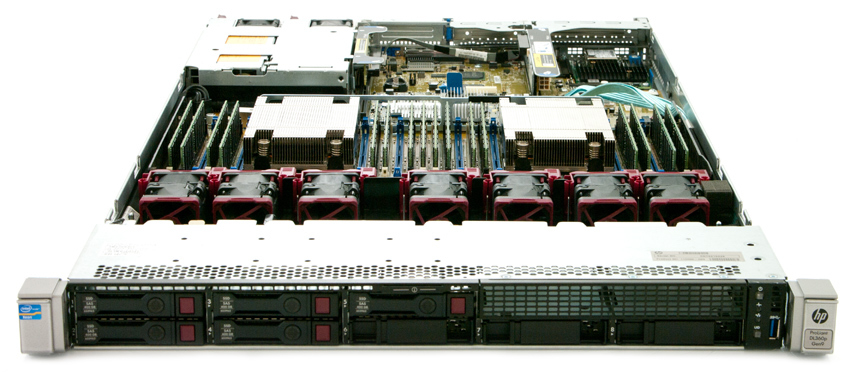
The ventilation network provides cooling from the front of the system. Our configuration uses two Intel Xeon E5-2697 v3 2.6GHz processors and 16 of 24 DIMM slots. The system uses the DIMM16GB 2Rx4 PC4-2133 DDR4 form factor with a total of 256 GB DDR4 memory. The microSD slot is located between the power supplies and the DIMM slots. A secondary PCIe riser with a third PCIe slot can be used for dual-processor DL360 server configurations, as in our case, the FlexibleLOM slot and two SATA ports are also located on the rear side.

DL360 Gen9 servers are equipped with one standard PCIe riser with two PCIe slots, while an optional riser provides a third PCIe slot for dual-core configurations. The back of the server includes a VGA port, a built-in 1GbE four-port network adapter, an iLO control port, a serial port, two USB 3.0 ports, an LED device ID and access to the FlexibleLOM card, in this case in a configuration with a PCA FLR 10GbE SFP dual-connector transceiver and network interface.
Our server is equipped with dual 800W Flexible Slot Platinum hot-swappable power supplies with an efficiency of 94%. The design of the HP Flex Slot PSUs allows for hot swapping and does not require tools to install on HP ProLiant Gen9 servers. Currently available models are 500W, 800W and 1400W.
Control
The HP ProLiant Gen9 servers are designed for commissioning using a single Extensible Firmware Interface (UEFI), but it also accepts the old boot mode.
HP Integrated Lights-Out (iLO) is an HP intelligent management system integrated into HP servers for agentless management. Agentless Management communicates using the Direct Media Interface (DMI) and can also be used in conjunction with Intelligent Provisioning to deploy and upgrade servers without configuring an environment with reusable deployment profiles. ProLiant Gen9’s new backup features include the ability to access 1 TB of HP StoreVirtual virtual storage at no additional cost and a new script to automatically install the server.
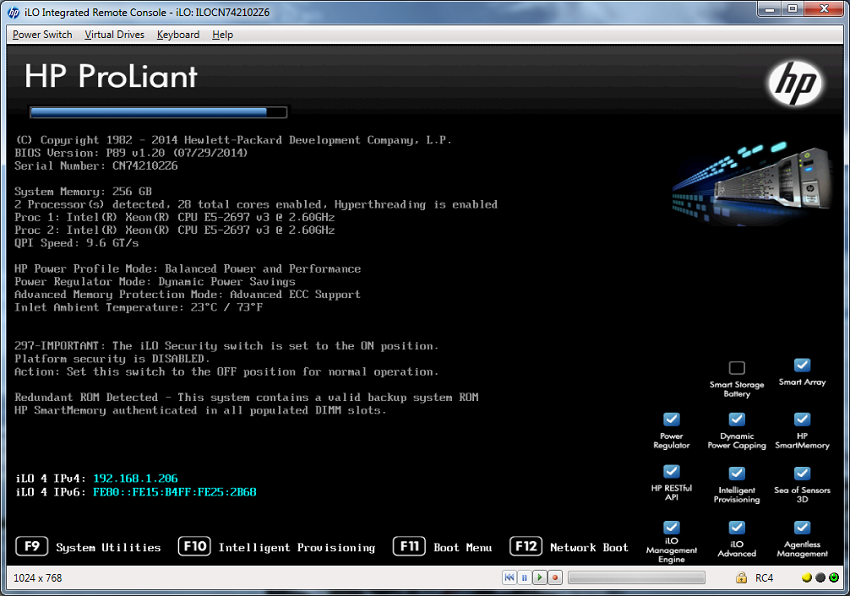
Standard features of iLO include Agentless Management, Active Health System, Embedded Remote support, and a new level of abstraction, the Adaptive ProLiant Management Layer (APML), to improve the temperature level to update system health data without reprogramming the system ROM and non-destructive online updates of temperature and ventilation data. On the new ProLiant Gen9 servers , the iLO Federation function has been added, which allows to detect and manage multiple servers, as well as providing access to 1TB of space for additional storage use when 4 GB of iLO NAND is connected to the server. Various iLO licensing schemes are available that provide various aspects of iLO Federation functionality.
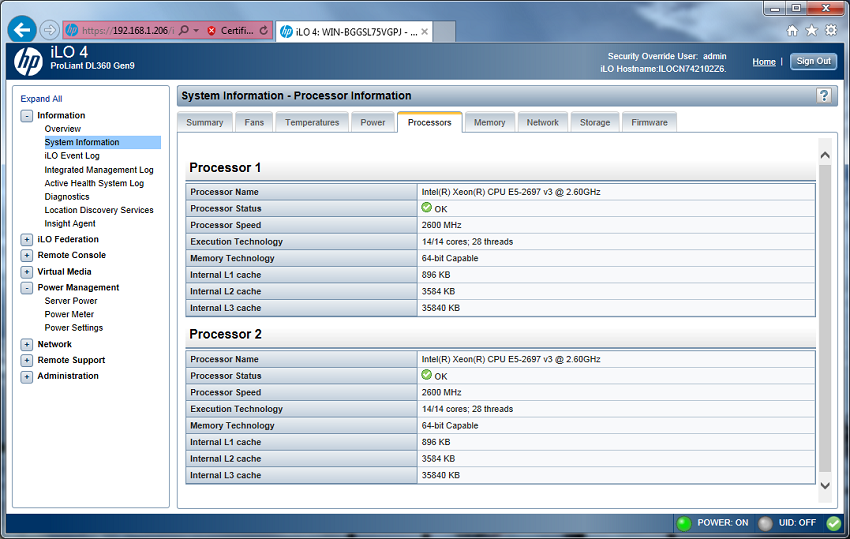
The HP Active Health System (AHS) is an integrated component of HP iLO Management for self-diagnosis. AHS monitors server health, real-time configuration and telemetry on iLO 4, system ROM, complex programmable logic devices (CPLDs), smart arrays, BladeSystem Onboard Administrator, Agentless Management Service and network interface cards. This provides synchronized monitoring and data collection across all systems for faster problem identification and can be automatically sent for HP analysis through a direct connection to Insight Online or Insight Remote Support 7.x.
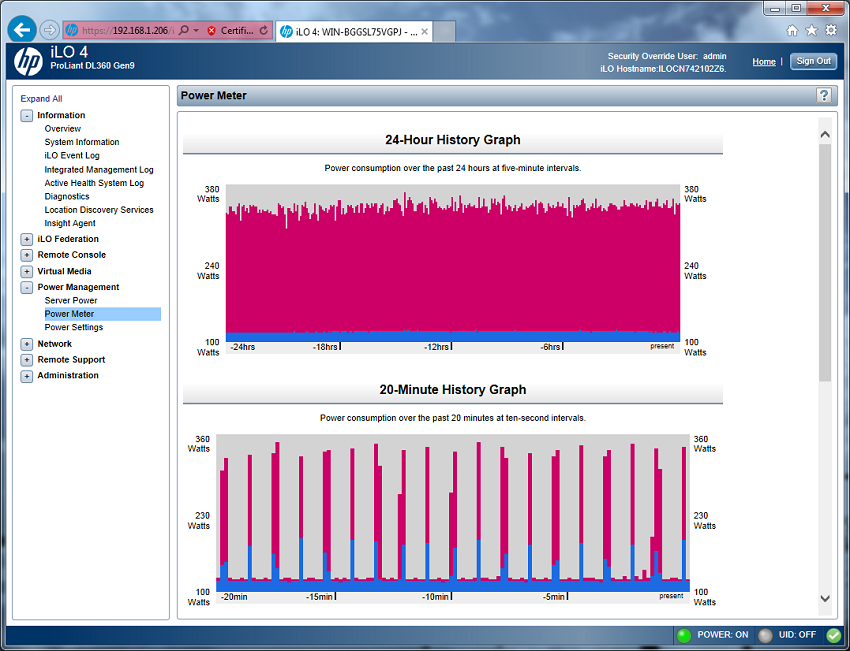
The iLO mobile application for iOS and Android can interact directly with the iLO processor on ProLiant servers to provide access to the state and protocols of the system, as well as scripts and virtual environment. HP's new RESTful tool for HP ProLiant Gen9 servers uses an API that can create configurations to quickly deploy ProLiant servers , and also configures servers with heterogeneous operating systems. HP ProLiant Gen9 servers also support management through HP Systems Insight Manager 7.4 and HP Virtual Connect Enterprise Manager 7.4.

HP Gen9 servers are currently shipped with Insight Control software. HP Insight Control includes automated server deployment and move tools along with integration of virtual machine management with VMware ESX, Microsoft Hyper-V, Citrix XenServer, and Xen on Linux VMs. Performance management tools detect and analyze hardware configuration problems and performance constraints.
Insight Control includes centralized monitoring and control tools for server power consumption and heat dissipation. Access to HP Insight Control is through Systems Insight Manager (HP SIM) through a network graphical user interface. HP Insight Control runs on a Windows-based Central Management Server (CMS) and can manage Linux and Windows hosts. Remote management features include graphical remote access (Virtual KVM), team collaboration, server loading and error videos, video reporting and on-demand playback, and remote access to a virtual environment.
License keys for the HP OneView and HP Insight Control are provided on the same system for customers planning to upgrade to OneView as soon as possible in 2014. OneView is designed to integrate HP server management , storage and networking by offering software-defined templates, a centralized automation center, and other features designed to fundamentally transition to Infrastructure as a Service (IaaS) and hybrid cloud architecture.
The HP OneView can be combined with VMware vCenter, Microsoft System Center, Red Hat Enterprise Virtualization (RHEV), HP Universal Configuration Management Database (UCMDB), and HP Operations Orchestration. HP Insight Online comes with an HP warranty and is contractually serviced. Insight Online is a cloud-based and supported portal with a dashboard that monitors service events, displays device configurations and monitors HP contracts and warranties. The HP Support Center app provides access to Insight Online data for mobile devices.
HP Insight Online Direct Connect, a small to mid-sized remote service offering, enables ProLiant Gen8 / 9 servers and BladeSystem c-class blade systems to send hardware failure and diagnostic information directly for analysis, script generation, and automated part replacement.
HP Insight Remote Support uses local server hosting to collect data and send it to HP. The service is developed by IT environments with a maximum of 2,500 devices. Insight Remote Support can control the predecessors of the HP ProLiant Gen8 servers , as well as HP storage and network products. Insight Remote Support is available both through the local console and through the online dashboard.
Test conditions
We publish information on laboratory resources, network capabilities of the laboratory and other details of our testing so that administrators and those responsible for the purchase of equipment can fairly assess the conditions under which we achieved these results. To maintain test independence, none of our reviews are funded or managed by the manufacturer of the equipment we test.
Our first results relate to the HP ProLiant DL360 Gen9 Serveras standard with a RAID10 array using four installed solid state drives and the fifth as a boot disk. The second set of results relates to the performance of FlexibleLOM PCA FLR 10GbE SFP server DL360 + network interface cards connected to the all flash array to demonstrate network storage capabilities.
Simulated enterprise load analysis
For each assessment, we previously transferred the device to a stable state with a significant load of 16 threads with 16 queues in the thread. Then, the storage will be checked with many variations of flows and queue depth to determine the performance at low and high loads.
Preliminary preparation and first checks in stable condition:
- Throughput (total I / O operations per second (IOPS) when reading and writing)
- Average latency (average latency when reading and writing)
- Maximum delay time (maximum delay time when reading and writing)
- Standard deviation of the delay time (standard deviation of the delay time when reading and writing)
This analysis includes four profiles that are widely used in manufacturers specifications and benchmarks:
- 4k - 100% read or 100% write
- 8k - 100% read or 100% write
- 8k -70% read 30% write
- 128k - 100% read or 100% write
With workloads made up of arbitrary 4k operations, the ProLiant DL360 Gen9 achieves 244,058 read I / O operations per second and only 41,021 write I / O operations per second using the internal RAID10 array. Combined with the all flash array, the DL360 10GbE is capable of withstanding 253,984 I / O operations per second when reading and 300,743IOPS I / O operations per second when writing.
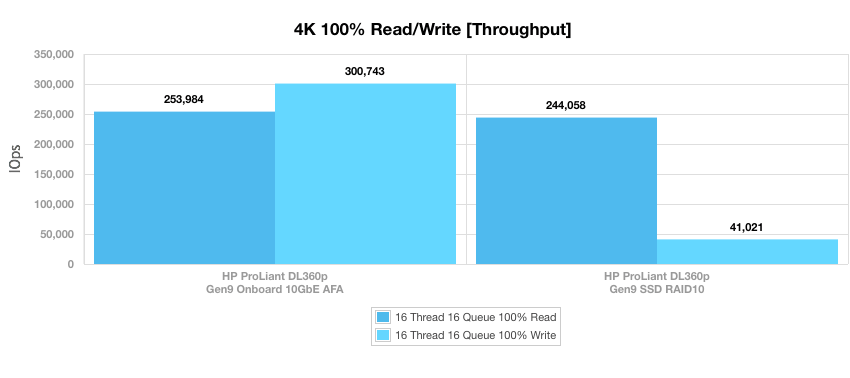
The average latency of the internal RAID10 array was only 1.05 ms for reading and 6.24 ms for writing. The average delay time of the 10GbE interface with the all flash array was 10.1 ms for reading and 0.85 ms for writing.
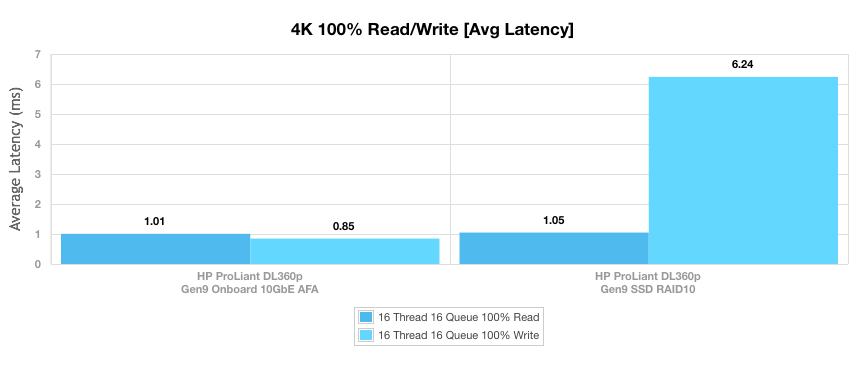
The maximum delay time of the DL360 Gen9 is 86.6 ms when reading and 112.3 ms when writing. The maximum delay time of the DL360 10GbE network interface with the all flash array was 60.9 ms when reading and 28.4 ms when writing.
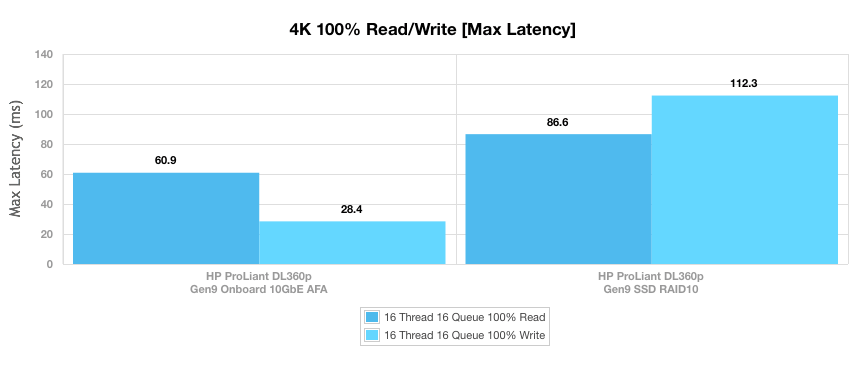
The standard deviation results indicate that there are large changes in the latency results for 4k write operations on a RAID10 SSD, which is consistent with the results shown above.

After changing the conditions of the server and the all flash array for serial transmission of 8k data, we measured the throughput under a load of 16 threads and with 16 queues in the stream for 100% read and 100% write operations. Gen9 DL360 RAID10 internal storage results were 147,178 I / O per second for sequential read operations and 36,786 I / O per second for write operations. The 10GbE network interface with the all flash array showed 159,158 I / O operations per second for read operations and 217,183 I / O operations per second for write operations.

The following results were obtained on the basis of a protocol composed of arbitrary read operations of 70% and write operations of 30% 8k with different load flows and queues. No combination of threads and queues created unexpected difficulties for the DL360 Gen9 server with RAID10 array. The bandwidth of the RAID10 array is approaching its maximum of 75,147 I / O operations per second with 16 threads with 8 queues per thread. The bandwidth of the 10GbE interface to the all flash array with 16 threads and 16 queues in the stream reaches 218,801 I / O operations per second.
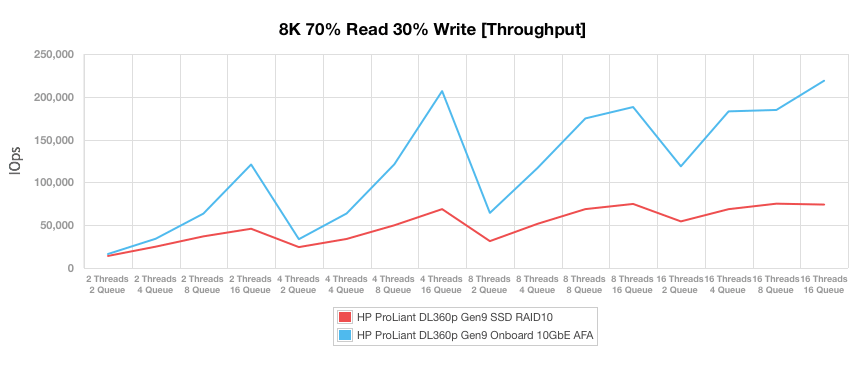
During the first few cycles of the 8k workload in the 70/30 benchmark test, the 10GbE all flash array configuration kept the average delay time at a theoretical minimum of about 0.23 ms. None of the configurations showed any weaknesses in terms of average latency.

The RAID10 array experienced several noticeable jumps in latency at large queue depths. During the heaviest load of the 8k 70/30 network interface, a jump in the delay time occurred, the rest of the time the maximum delay was consistent.
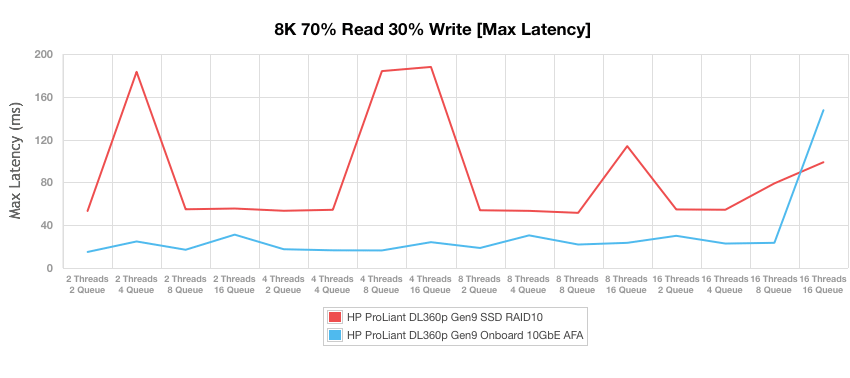
The standard deviation of the delay time in the 8k 70/30 benchmarking test also reflects the maximum delay time in a multi-queued RAID10 configuration. The standard deviation results show that the RAID10 array suffers most of the difficulties of sequential delay time at maximum load.
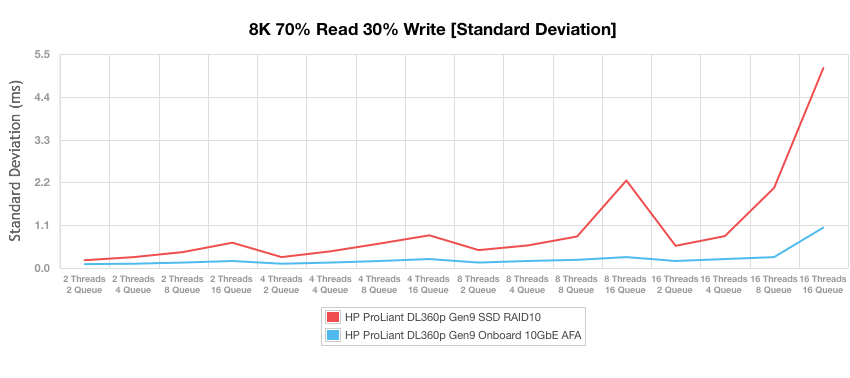
Our final testing is based on 128k serial transmission with 100% read and 100% write operations. The Gen9 ProLiant DL360 RAID10 internal array can withstand 1,678,541 Kb / s for read operations and 637,581 Kb / s for write operations. When evaluating the additional dual network interface 10GbE Gen9 DL360, the result was 2,311,475 kB / s for read operations and 2,310,042 Kb / s for write operations.
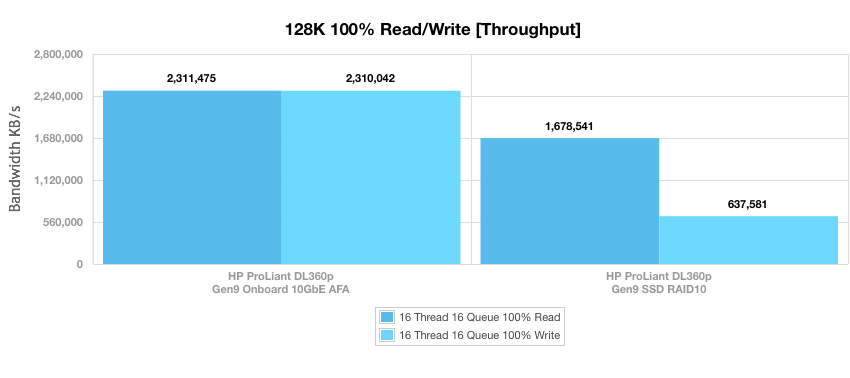
Conclusion
The HP ProLiant DL360 Gen9 has a design that can serve as a useful component in a converged enterprise or data center architecture, along with HP’s OneView platform and other management innovations, making it easy to coordinate the work of hundreds and thousands of servers. For those with more modest goals, the DL360 Gen9 offers storage density and processing power as a flexible and efficient complement to many environments. In the DL300 family, HP has embraced major technology advances, including support for the latest Intel chipset, DDR4 DRAM, 10GbE, and SAS3. In our case, the server is connected to 2.5-inch solid-state drives, although the DL360 server could be used with four 3.5-inch drives, depending on your preferences. In general, there’s nothing revolutionary in the DL300 family,
In our configuration with five "outdated" solid state drives based on a small logical controller in the SAS2 interface based on SanDisk Pliant, we got the expected stable operation. In addition to the high performance of internal storage, the availability of high-performance 10GbE interfaces means that the DL360 Gen9 can be placed higher than high-speed storage arrays in order to carry out a large number of input-output operations with minimal delay and fewer cables. In many cases, the load against storage will prove to be the most popular use case. In our testing, we connected the DL360 Gen9 serverwith the all flash array based on Windows Server 2012 R2 and achieved performance that easily surpasses the dual 10GbE connection. We applied a significant load of mixed I / O operations, with a maximum load of 218,000 arbitrary I / O operations per second of 8k 70/30, as well as 2.3 Gb / s of sequential operations. Since the internal FlexibleLOM slot handled this, we were able to leave all the additional PCIe slots free for future use.
Updated ProLiant Gen9 Familycontinues to be the most reliable among servers. HP took all new developments and applied them in the server. While we have noticed that other manufacturers are experimenting with storage densities in the 1U and 2U form factors, HP is playing a big game, providing customers exactly what they need. While others only apply new technology to some products, HP’s position is more pragmatic; when there is a sufficiently large demand for a new technology, they introduce it. At the moment, they rely on a good reputation for build quality, management and cost structure, which put them at the forefront of server manufacturers.
Benefits
- The dual-port 10GbE network capability provides high-speed network connectivity for high-performance storage arrays.
- A wide range of management tools inside and outside the HP management ecosystem
- Improved storage capabilities, including support for SAS3 SSDs
disadvantages
- Long-term non-critical software / BIOS updates require a service contract
Total
HP ProLiant DL360 Gen9 offers data centers that are managed by compact computing servers with a 1U form factor, based on the origin of the HP server and providing an advantage in performance and power over the previous Gen8 family.
Comrades, please do not judge strictly, the post was published at night and forgot to design it as a translation.
The original article is here: www.storagereview.com/hp_proliant_dl360_gen9_review
From myself I can add that we conducted this test (repeated) at a bench with our friends in the UK.
